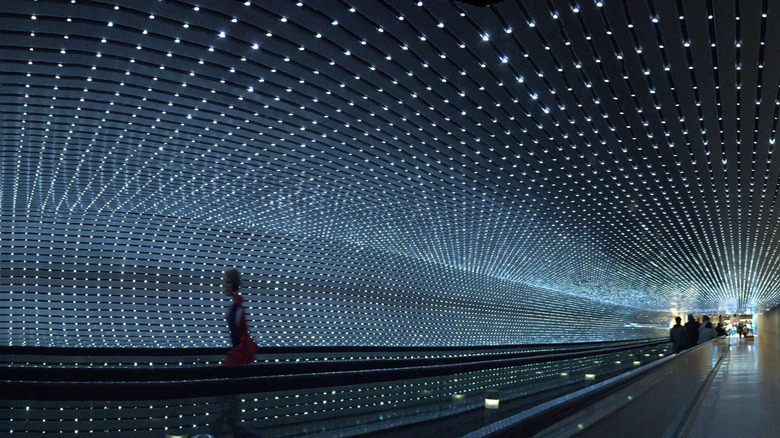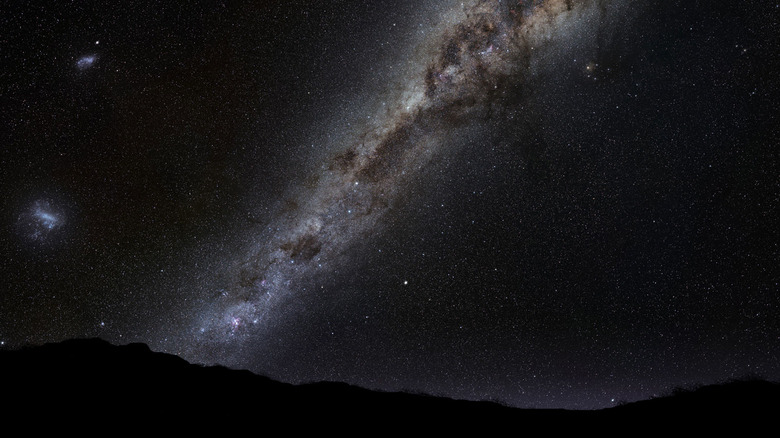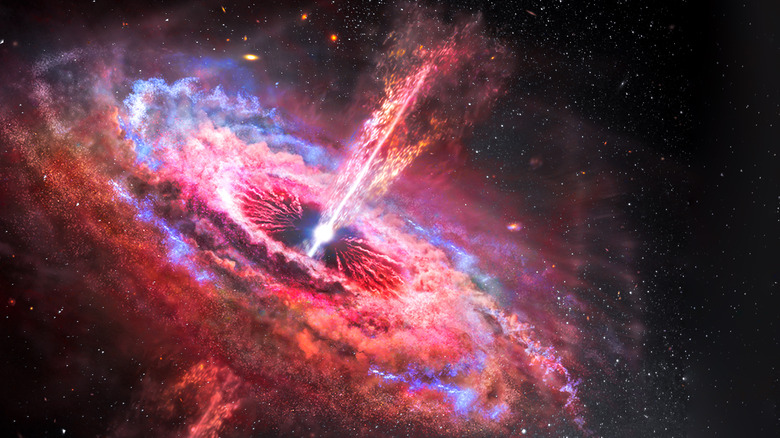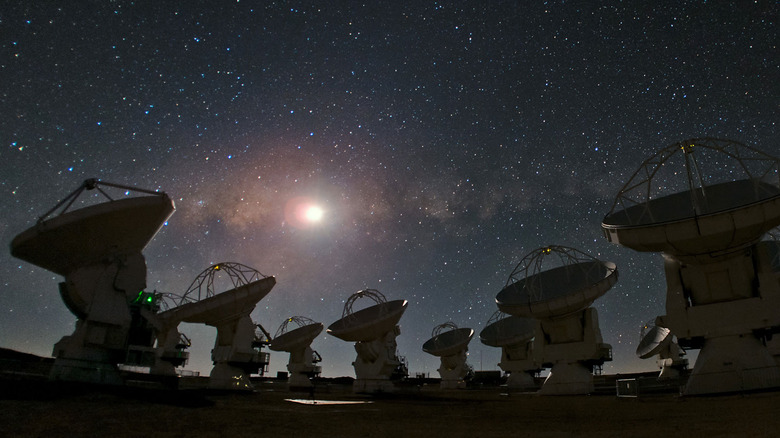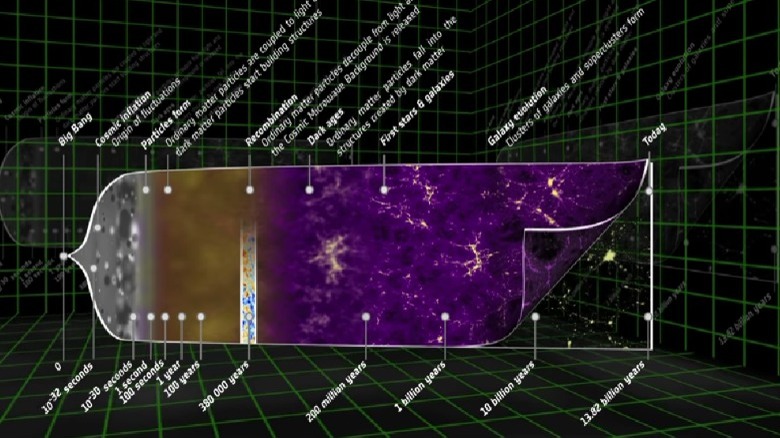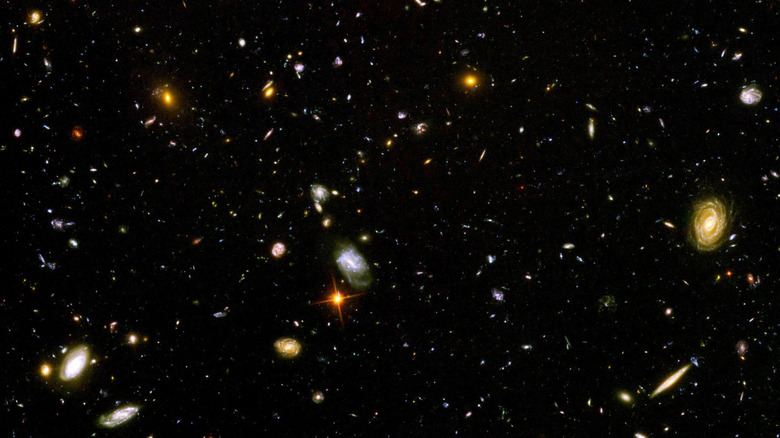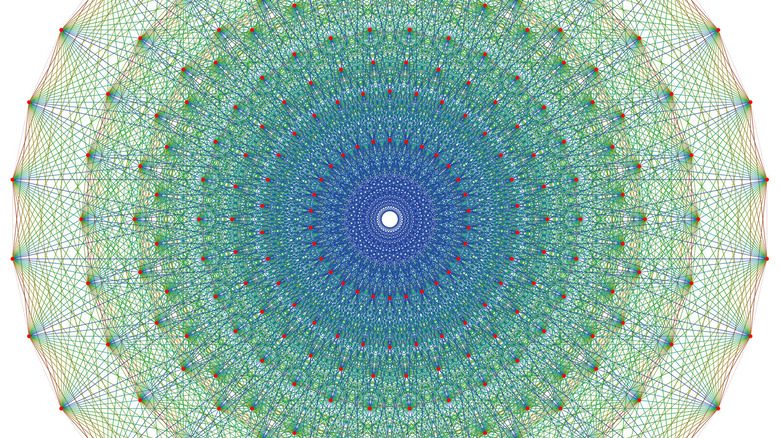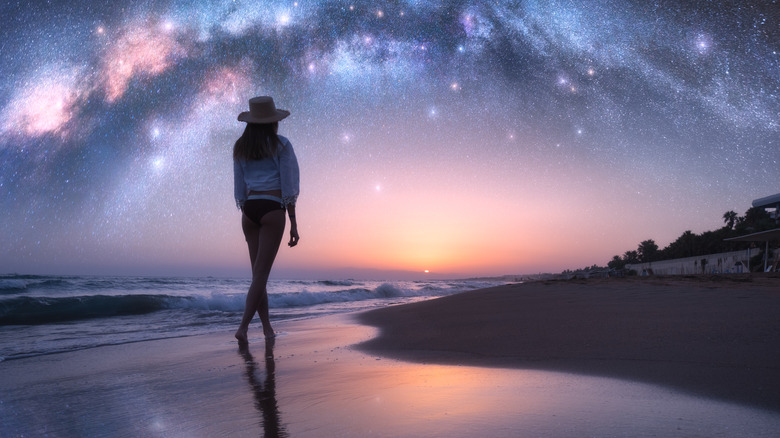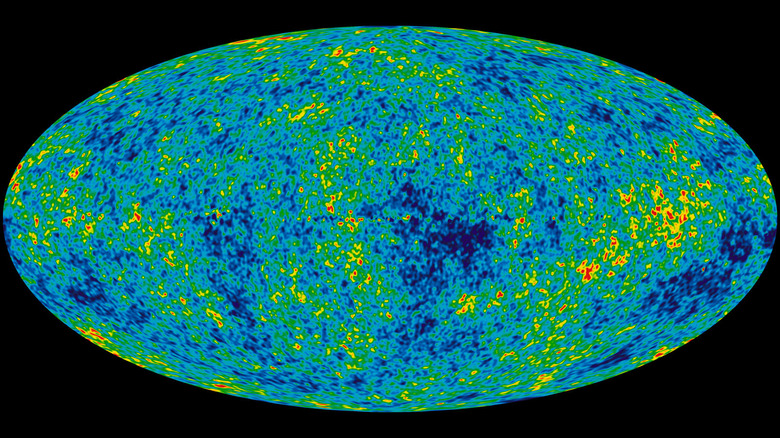The Multiverse Theory Completely Explained
Nearly 14 billion years ago, there was nothing. Then, all at once, there was everything. Our entire universe burst into existence in a cosmic explosion known as the Big Bang, and everything that ever was or will be is contained within it. Every last iota of time, pulse of energy, and morsel of matter. At least, that's what is taught in school. But this still leaves the fascinating possibility that, if our universe can exist, maybe others could too.
The multiverse concept is the idea that our universe is just one of many other universes. As Forbes explains, the multiverse is not really a theory but a result of theories. Simply, if we understand reality well enough, a multiverse should exist.
Our universe is so vast it's difficult to fully comprehend. Our brains never evolved to contain concepts so large. As Live Science explains, it's 13.8 billion years old and stretches out for over 46 billion light years in every direction. Everything we can see of the cosmos is known as the "observable universe," containing at least two trillion galaxies like ours. But as explained by renowned cosmologist Katie Mack, there's almost certainly more beyond these limits. Here is the multiverse theory explained.
The Ancient History of the Multiverse
The multiverse may seem like a modern idea, but it has roots growing far deeper in human history than you may realize. One of its earliest forms came from ancient Greece. As Scientific American explains, it was important in the philosophy of atomism, with philosophers like Democritus devising theories that required infinite worlds to work. As Professor of Religion Mary-Jane Rubenstein explains, their atomic theory meant that they no longer needed to rely on gods to explain the apparent perfection of their world. To the atomists, our universe was just one of an infinite number of others, each totally different. Democritus lived over two millennia ago, but his ideas were somewhat similar to some more modern ones.
The Greeks weren't the only ones to explore the idea of other universes though. An ancient Hindu philosophical text, Śrīmad-Bhāgavatam (Bhagavata Purana), talks extensively about cosmology. It mentions how "there are innumerable universes besides this one." This Persian polymath Fakhr al-Din al-Razi touched on a similar idea in his 13th-century book, "Matalib al-'Aliya (volume 4)." An article in the book "Islam and Science: Volume 2" explains how al-Razi analyzed a verse in the Qur'an which states "all praise belongs to God, Lord of the Worlds" and whether this may refer to other worlds within our own cosmos, or a multiverse beyond our own.
Multiverses in Pop Culture
The meaning of the word multiverse originates in science fiction. The book, "The Superhero Multiverse," attributes it to a 1963 novella, "The Sundered Worlds," by Michael Moorcock. It's since become a staple of science fiction, recurring in all kinds of contexts. And with good reason — the idea of parallel worlds with different versions of yourself is a compelling one, carrying a host of thought-provoking questions, both tantalizing and troubling.
"Spider-Man: No Way Home" asks the somber question of whether there are some tragedies that every version of yourself is destined to face. Rick and Morty's episode, "Close Rick-counters of the Rick Kind," nihilistically asks what it might mean to be the best version of your alternate selves. The 2013 indie sci-fi movie "Coherence" gives an unsettling examination of parallel realities, as a group of people encounter alternate versions of themselves. It explores how their lives could have gone very differently, all with their basic personality traits remaining exactly the same.
Science fiction usually bases its ideas on one multiverse concept –- that every time a decision is made with multiple outcomes, every possibility is played out in a separate newly created world. As fantastical as it may seem, the bones of this idea come from hard science. Specifically, from the weirdest part of physics, quantum mechanics.
The Many Worlds of Quantum Mechanics
Erwin Schrödinger is a name that any physics student will recognize. He was so instrumental in devising the deeply vexing theory of quantum mechanics that his name is nearly synonymous with it. He's probably most famous for the Schrödinger's Cat thought experiment, as Discover Magazine explains. If a cat, trapped in a box, has a 50:50 chance of being alive or dead, there's no way of knowing for sure until you see the cat yourself. The bizarre conclusion is that, until you open the box to check, the cat is both dead and alive at the same time.
Similarly strange is the way quantum mechanics predicts parallel realities. The book, "The Simulated Multiverse," explains that during a lecture in 1952, Schrödinger explained an idea that he himself cautioned might sound crazy. Interpretations of his quantum equations suggested that, rather than there being a single course of history, there are actually several, each one as real as the one you're currently experiencing and each happening simultaneously.
This concept, with potentially infinite worlds all occupying the exact same space and time, is formally known as the Many-Worlds Interpretation of Quantum Mechanics. As the Stanford Encyclopedia of Philosophy explains, this gives reality a seemingly infinite complexity. For every quantum event with multiple possible outcomes, every outcome really happens. Every possibility is played out, somewhere in a different parallel reality. This, however, is just one of the many types of multiverse that have been hypothesized.
The Multiple Multiverses
While pop culture tends to borrow the many-worlds idea from quantum mechanics, it's not the only kind of multiverse possible. Other kinds aren't mutually exclusive either, so people may be living in more than one kind of multiverse at the same time.
Nature explains how string theorist Brian Greene has hypothesized nine different kinds of multiverse. The simplest of these is plain physical cosmology, and the idea that there's more of our universe than can be seen. More abstract possibilities include the idea that the universe is actually a hologram, or even the philosophical argument that, statistically, everything that can possibly exist must do so somewhere.
Cosmologist Max Tegmark has also made an overlapping multiverse classification, described in the book "Science and Ultimate Reality: From Quantum to Cosmos." Tegmark's types range from a simple extension of our own universe to other universes where the laws of physics themselves are fundamentally different.
If all of this is a lot to take in, that's understandable. After all, people have spent entire careers thinking about these concepts. And all of this is before even considering how many other universes the multiverse could contain -– but that number may not be endless. New Atlas discusses Stephen Hawking's final paper that suggests that, while there may well be more than one, the number of possible universes out there is likely to be finite.
Occam's Razor
The multiverse concept can be a divisive one among scientists, but this varies wildly depending on the specific multiverse idea being considered. As Britannica discusses, the biggest criticisms are that some multiverse hypotheses are too speculative, being more philosophy than science. Another sticking point that many critics bring up is testability. Scientific method dictates that, for a hypothesis to be sound, it must be possible to test it to see if it's true. Therein lies the rub. Smithsonian Magazine explains that a problem with multiverse theories is that some of them may not be testable at all. Which is a fair point. It's impossible to see anything outside our own universe, by definition, making it seemingly impossible to ever see another one.
A principle that is often invoked in these arguments is known as Occam's Razor, which essentially states that, when there are two competing ideas to explain the same concept, the simplest idea is the better of the two. Multiverse critics would argue that, as people cannot observe any universe beyond our own, the best conclusion is that ours is the only one. Others counter this with the explanation that multiverse theories are well within known and understood physics. Caltech physicist and vocal multiverse proponent Sean Carroll, for example, emphasizes that the science behind multiverse theories is perfectly sound and even straightforward, based on staple scientific methodology like empiricism and reasoning. It's simply a matter of taking what is already known and extrapolating.
Life in a Black Hole
A black hole with the mass of the entire observable universe would have nearly the exact same size as the observable universe. Forbes explains this remarkable coincidence and the possibility it raises that our entire universe may lie within a black hole.
Black holes are interesting things because they warp the fabric of reality so much that physics starts to break down. One of the best ways to understand the physics of something is to break it apart and pick at the pieces. As a result, a lot is known about how black holes work, while still having the kind of unanswered questions that give theorists headaches.
As far-fetched as it may seem, there's an entire model of cosmology dedicated to exploring whether our universe may be the interior of a black hole, discussed in detail in the American Journal of Physics. The implications are fascinating. The Milky Way is full of black holes, from the stellar mass Cygnus X-1 to the mighty Sagittarius A* at the galaxy's heart. If black hole cosmology is right, it implies that each of these could be an embryonic universe.
This idea is also a contentious one, however. It's so far failed to match up to the universe seen around us, leading cosmologists like Sean Carroll to dismiss the hypothesis as nonsensical. A compelling idea, perhaps, but so far it's seemingly little more than that.
Beyond The Cosmic Horizon
The very edge of the observable universe lies 46 billion years away, as Live Science explains, and that's where our vision ends, limited both by the speed of light and by the age of the universe itself. Sometimes referred to as a Hubble volume, it marks a spherical region of space around us. However, as noted by cosmologist Katie Mack, just because you can't see past the horizon does not mean it's the edge of the universe.
In the universe's first moments, it expanded explosively, ballooning by 100 trillion trillion times in less than the blink of an eye. This, as Space.com explains, was an event known as cosmic inflation. Fleetingly brief, inflation set the stage for our universe to grow into the way seen today, but it also carries the notion that there may be much more unobservable universe.
In "Science and Ultimate Reality: From Quantum to Cosmos," Max Tegmark discusses a prediction of this inflation, that the universe may potentially be infinite. In such an infinite universe, according to statistics, everything possible will happen. This means that, far enough away, there would be another reality like this one, with an identical copy of yourself. The distance you'd need to travel is so absurdly large that it's difficult to even write down. But you'd never be able to go there. The expansion of the universe itself would make the journey impossible.
Inflatable Universes
Inflation has other predictions up its sleeve though. One interesting hypothesis is known as eternal inflation, explained by Science Alert. In this idea, inflation may have stopped in our universe, but it never actually stopped elsewhere. As inflation continues, smaller bubbles of space slow or stop, becoming separate universes. An endless mass of universe bubbles in the roiling foam of an ever-expanding multiverse. Our own universe would have started out as a little pocket surrounded by inflating space, before growing into the cosmos seen today.
Once inflation stops in one of these bubbles, it's then left to expand at a more leisurely pace, forming stars, galaxies, planets, and even people. Physicist Alan H. Guth explains how, even with our incomplete understanding, inflation gives an accurate description of our own universe. If eternal inflation is correct, it would mean that the multiverse contains an infinite number of these pocket universes.
Not everyone likes this idea. As Science Alert notes, one notable critic is Princeton physicist Paul Steinhardt, one of the people who originally devised the idea of eternal inflation before ultimately rejecting it. All the same, the eternal inflation hypothesis still has some momentum behind it. In an interview with Horizon Europe, physicist Thomas Hertog describes a way to hunt for evidence of it by searching for gravitational waves left over from the Big Bang itself.
Where Our Rules Don't Apply
As any fan of classic "Star Trek" will know, ye cannae change the laws of physics. While this may be true for humans, the universe itself may be under no such restrictions. According to Science Daily, there's some evidence that those laws of physics may not be the same in other parts of our universe. A mysterious piece of physics, known as the fine structure constant, is an essential component in understanding reality. Usually referred to by the Greek letter alpha, the fine structure constant relates to other physical constants like the speed of light, Planck's constant, and the elementary charge of electrons. But this constant may not be so constant.
A study published by Physical Review Letters reports evidence that the value of alpha may change in different parts of the universe. It's still a debated finding and hasn't been unambiguously confirmed to date but, if true, it lends support to the idea that other universes may operate under very different rules. As Max Tegmark explains in an article for Scientific American, there's good reason to believe that other universes may have different physics to our own. This could happen in the pocket universes formed by eternal inflation, or could even occur in a cycle of destruction and rebirth of universes.
Brane Power
Max Tegmark's Scientific American article also discusses the idea that the multiverse may be higher dimensional –- that is, it may contain more than the typical three dimensions. In this model, our existence is confined to a three-dimensional surface known as a brane. This idea is known as brane cosmology. According to Progress of Theoretical Physics Supplements, a brane (short for membrane) is the familiar space people know, embedded in a higher-dimensional spacetime. Known as the "bulk," this spacetime may contain five or more dimensions.
The word brane relates to M-theory, a contender for a possible "theory of everything" that some physicists are trying to develop to fully describe reality itself. According to Space.com, M-theory posits that the universe is made up of 11 spatial dimensions, with the space taking up just three of them.
The bulk spoken about in brane cosmology could separate any number of three-dimensional branes like ours. As Tegmark explains, this could give a rather literal meaning to the term "parallel universe." Any number of other universes could exist on other branes, which genuinely are parallel to ours. Though, admittedly, the concept of multiple three-dimensional spaces being parallel to each other is not an easy thing to visualize.
Does The Matrix Have You?
In 2005, a group of theoretical cosmologists known as the Virgo Consortium ran a simulation of the universe. In what the Max Planck Institute called the largest cosmological simulation ever, it gave a picture of how galaxies form and how dark matter interacts at the largest scales. Of course, even our most advanced scientists are still unable to simulate a whole universe down to the level of individual atoms. Someone else out there, however, may have computing capabilities that could make our best supercomputer look like an abacus.
A disconcerting idea, the simulation hypothesis suggests our reality may not be as real as thought. Scientific American explains how philosopher Nick Bostrom originally formalized the idea in 2003 and, since then, it's been grappled with by physicists and fiction authors alike. Some suggest the odds may be 50:50 that everything is an elaborate simulation, and the chances may even increase with the creation an artificial consciousnesses -– although what a consciousness might even be is an altogether different philosophical question.
If our universe is a simulation, it could be just one of many, and it's existentially troubling to realize that people have no way of knowing.
The Ultimate Multiverse
It's still up for debate which of these multiverse ideas may actually be real and which are little more than interesting ideas but, all the same, it would be helpful if they could be described in the same way. A challenging idea, considering how different they all are. This is where ultimate ensemble theory comes in.
Ultimate ensemble theory, also known as the mathematical universe hypothesis, is the abstract idea that all universes are equally real if they can be described by mathematics. But it goes deeper than just descriptions. In a paper published in Foundations of Physics, Max Tegmark argues that our physical world itself is mathematics. In this idea, a universe is a mathematical structure –- a vast collection of objects that can be formally defined by mathematics. This may seem too abstract to be real but, in its simplest form, it's essentially just a logical truism. For a thing to be real, it must be possible. If math can't describe it, then it cannot be real and is therefore impossible.
In Tegmark's own words, reported in an interview with Discover Magazine, "there is only mathematics; that is all that exists," an idea that would make Ancient Greeks like Pythagoras very happy. While it feels somehow even more abstract than the notion that reality is a simulation, there's a certain beauty in the simplicity. It makes sense that physical laws appear to be so simple if, deep down, they're literally nothing but math.
Modal Realism
A lot of multiverse ideas are, ultimately, philosophical. This ties in to a specific school of thought known as modal realism, championed by philosopher David Lewis in his book, "On the Plurality of Worlds." Modal reality says, in a nutshell, that all possible worlds are real in the same way as the actual world. If something can exist, then it does exist, making our entire cosmos just one of a vast plurality of "cosmoi."
This may make any book you read feel a little bit like "The Neverending Story," but it's useful in physics too. As the Internet Encyclopedia of Philosophy explains, it underpins the idea that if something observable is theoretically useful, this is a good reason to believe that it exists -– a basic assumption that lies behind all scientific hypotheses. In standard scientific method, one must assert that something can exist before devising a way to prove it.
Lewis' ideas link back to a rather older concept that came from the 17th-century philosopher Gottfried Wilhelm Leibniz. Leibniz's "best of all possible worlds" idea, described by Britannica, is rather more religious than Lewis' work though, asserting that God would only create the best possible world for us. He intended to reconcile an old argument in theology, the question of why, if the universe was made by an omnipotent creator, evil still exists. The interesting thing is that Leibniz's argument is similar to a cosmological idea known as the anthropic principle.
The Anthropic Principle
The anthropic principle is a philosophical argument in science in an attempt to explain how our universe appears to be ideal for intelligent life, like us, to exist. Britannica discusses this idea extensively. Much like Gottfried Wilhelm Leibniz, some scientists have argued that our world is the best one possible for us to live in. Astronomer Fred Hoyle used the principle to explain why carbon, versatile and essential for life on Earth, is so abundant in the universe. Stars appear finely tuned to create it and, if they didn't do so, people wouldn't be here to wonder why.
This is the crux of the anthropic principle. Its simplest form is simply a truism, that our universe has the conditions for life to exist because people exist within it. A stronger stance (known, fittingly, as the strong anthropic principle) is that the universe genuinely is fine-tuned for life to exist, therefore life must exist in there. But this idea is easily misunderstood..
Forbes explains how scientists misuse the anthropic principle, inadvertently constructing logical fallacies. One such leap in reasoning is the idea that, because our universe exists as it is, other different universes must necessarily exist too. But the anthropic principle says nothing about a multiverse. Instead, it only refers to our own universe, irrespective of whether or not there are others.
Searching for Traces of Another Universe
Amid all the philosophy and abstraction, there are some rigidly scientific attempts to hunt for other universes. One good place to look is in the last echoes of the Big Bang itself, and this search began with the Wilkinson Microwave Anisotropy Probe (WMAP), launched into orbit in 2001.
WMAP's image of the Cosmic Microwave Background (above) shows the faint background radiation that pervades the entire universe around us. As NASA explains, it's the last remaining light from the Big Bang, stretched tenuously thin as the universe itself continues to expand and constantly bathed us with this invisible primordial light. Switch on an old CRT TV set, and you can see it in some of the fuzz on-screen.
As Scientific American explains, cosmologists have attempted to use this as a snapshot of the very first moments of the universe, when inflation was driving that initial burst of growth. Their idea was that, if the eternal inflation idea is correct, then our universe may have collided with others during its first moments of life. This would leave an imprint that could potentially be seen in the Big Bang's fading glow. As Jennifer Ouellette explains for Quanta Magazine, while WMAP couldn't give any conclusive proof, it did identify four spots in the sky that gave hints of possible universe bubble collisions. PBS reports a follow-up idea, that such collisions may have left behind gravitational waves that could help to confirm these footprints of other universes.




